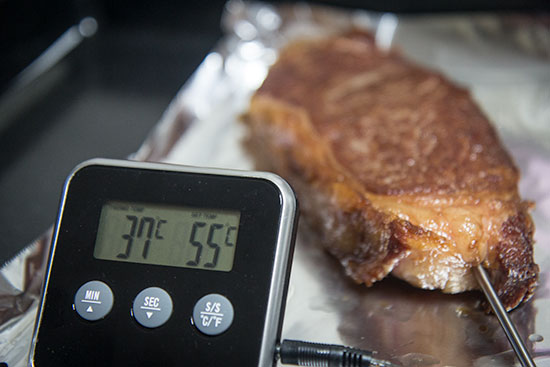
So medium rare. Much juicy. Yums!
The traditional way of cooking a steak has huge drawbacks. In order to get a nice crust you have to cook fast and hot. But because steak cooks from the outside in, by the time the middle is at your preferred temperature, the outer layers have become a grey shade of dry, well done meat.

Image courtesy of Colin McNulty
The solution, then ... is to freeze your steak before searing. Start off with a good piece of meat - like this beautiful $76.90/kg Wagyu Striploin - and plop it uncovered in the freezer on some parchment paper for about 30 minutes. You can see in the photo below that we used kitchen towels: Not a good idea as the steak's juices may saturate the towel and make it hard to remove.

From there just use your favorite searing method to get the maillard reaction going. Blowtorch'ing is the most convenient and fuss-free method but we still prefer oil in a smoking hot skillet. You'll note that we've used quite a lot of oil - this allows a greater surface area of the steak to get scorched by the oil since it's hard and may not conform to the flat pan all that well.

Once both sides are seared nicely we stuff a probe in the middle of the meat and bake in the oven at 70°C, at our chosen target temperature of 55°C (sort of in between Rare and Medium Rare). You can decide what temperature you want, of course! Rare starts at about 52°C, and Medium Well is at about 65°C. Any higher and honestly you might as well not bother eating steak.

Now the huge drawback for this method is controlling the cooking time. it takes anywhere from 30-50 minutes to reach a 55°C internal temperature, which is fine if your diners aren't fussy about waiting. But if you've got a hungry couple waiting at the dinner table and the thermo only reads 45°C ... well you get the idea :)

That yellow froth is milk solids from the melted butter
Now that your steak's ready you can garnish, season and serve - no resting necessary! For today we just melted a little butter and poured it over the top, with some salt and pepper to taste. Re-visiting this cross-section photo we can see there is a very minimal grey band of well done meat - 90% or more of the steak is perfect and just the way we like it. Juicy, tender, delicious!

So there you have our new favorite steak cooking method. We prefer this over sous vide because with a very cold steak you can actually put more heat on the sear to get a proper crust without worrying about the insides overcooking. We've also felt (subjectively) in the past that sometimes sous vide steaks turned out dry - which other blogger home chefs are noticing as well. Having said that, if we were planning a dinner party we would still go with sous vide because of the huge time window for serving the steaks to the guests.
Bon Appétit!

look like rare to me
ReplyDelete